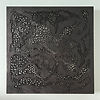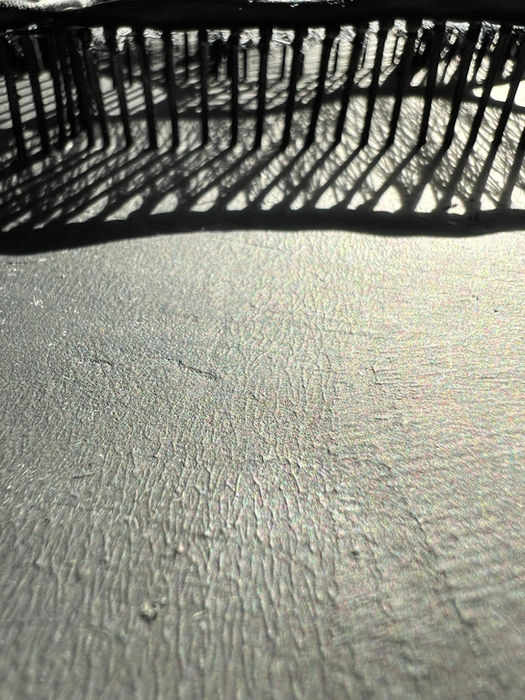
Processing, 2017
pine board, nails, thread, paint; 36"x24"
The dense clustering of screws creates a sensory pressure, but the flow of the shape softens it. It feels like standing inside your own thoughts: structured yet scattered, sharp and necessary.
Processing is a physical representation of the invisible architecture of experience. It reflects how thoughts take shape. What emerges is both patterned and chaotic, an emotional system built through repetition and friction. The form suggests motion, something alive and ongoing. There is pressure in the density, but also rhythm. A visual rendering of how the mind holds both structure and disorder at once.
This piece came from a time when I was trying to understand how thoughts form before they become language. I wasn’t looking to say something—I was trying to feel what it’s like when everything is unsaid but present. There’s tension in the clustering, but also calm in the repetition. Processing became a space to witness how mental noise arranges itself, slowly forming into something that makes sense—only after you’ve stepped back.

Metanoia, 2018
pine board, nails, thread, paint; 36"x24"
A quiet, transformative change of heart that emerges after deep reflection. This work speaks to confronting past selves, letting go without erasure and accepting without regret.
Metanoia explores the subtle shift that comes from internal reckoning. The piece captures the moment where clarity emerges. This is not a portrait of change, but of the air and feel that change leaves behind. A kind of emotional residue that lingers after a realization has settled. The materials serve both function and metaphor. As if identity is something pulled together under quiet pressure. The moment we begin to see ourselves differently, without needing to fully understand what comes next. The zebra being seen in bust form holds space for ambiguity. There is no clear beginning or end here, only the suggestion of movement through release.
When I created Metanoia, I was sorting through who I had been and who I no longer wanted to be. Hammering in each nail felt like pinning down a version of myself I wasn’t ready to fully let go of. I tried to make sense of the tension between remembering and releasing.
The zebra became a metaphor for this—an animal that can disappear into its own pattern, caught between standing out and blending in. Sometimes you know the road is ahead but you can’t help but look back one last time at the version of yourself that’s kept you here for so long. This time, the gaze softens and looking forward becomes easy, almost necessary.

Contour, 2017
pine board, nails, thread, paint; 36"x24"
My first experimentation with contoured raised lines on pine.

Contra, 2025
pine board, nails, thread, paint; 36"x24"

Cognition, 2025
pine board, nails, thread, paint; 36"x24"
Metanoia, 2018
pine board, nails, thread, paint; 36"x24"
A quiet, transformative change of heart that emerges after deep reflection. This work speaks to confronting past selves, letting go without erasure and accepting without regret.
Metanoia explores the subtle shift that comes from internal reckoning. The piece captures the moment where clarity emerges. This is not a portrait of change, but of the air and feel that change leaves behind. A kind of emotional residue that lingers after a realization has settled.
The materials serve both function and metaphor. As if identity is something pulled together under quiet pressure. The moment we begin to see ourselves differently, without needing to fully understand what comes next. The zebra being seen in bust form holds space for ambiguity. There is no clear beginning or end here, only the suggestion of movement through release.
When I created Metanoia, I was sorting through who I had been and who I no longer wanted to be. Hammering in each nail felt like pinning down a version of myself I wasn’t ready to fully let go of. I tried to make sense of the tension between remembering and releasing.
The zebra became a metaphor for this—an animal that can disappear into its own pattern, caught between standing out and blending in. Sometimes you know the road is ahead but you can’t help but look back one last time at the version of yourself that’s kept you here for so long. This time, the gaze softens and looking forward becomes easy, almost necessary.



Contra, 2023
pine board, nails, thread, paint; 36"x24"
Representing the kind of support that doesn’t come from sameness, but from standing opposite. About being seen not through reflection, but through contrast.
Contra is about the person who challenges us, who sees us most clearly, by forcing us to articulate what we stand for. This piece holds that space: the tension, the distance, the quiet kind of loyalty that doesn’t need to look like yours to be real.
With Contra, I kept thinking about the people who’ve pushed me the most—not out of harm, but out of honesty. The ones who never saw the world the way I did, but still stayed in it with me. There’s a strange kind of closeness in that. Sometimes it’s easier to show your truest self to the people who don’t agree with you, because you’re not trying to be liked—you’re trying to be understood.
This piece isn’t about harmony. It’s about the kind of presence that holds its ground and, in doing so, holds you too. Making space to disagree, holds space for both opinions. Sometimes you don’t see eye to eye. But you also have a set of eyes at the back of your head anticipating the things you tend to overlook. Sometimes, that counterweight is so right, it creates your balance in life.
Cognition, 2025
wood panel, paint; 24"x24"
A map of internal terrain, charting movement not through destination but through disruption. A flow of pathways across potholes pulled across a single plane. What’s visible here isn’t an image—it’s the residue of what passed through.
Cognition maps how we build meaning—not through certainty, but through disruption. The surface is divided like the mind; the open holes mark what’s been explored in our human experience. The painted lines show the conclusions we’re still drawing—some soft, some already hardening. But the more clustered they get, the harder it becomes to explore their grounds. This piece is about that moment: when the maps we’ve drawn start to trap us. When what we “know” gets in the way of what’s still possible to become.
I kept thinking about how much of what we believe is just repetition—lines drawn over and over until they feel permanent. But what if they’re not? What if we’ve only avoided the empty parts of the map because we’re scared of what we’ll find there? Cognition is my way of asking that. Of looking at the places I’ve stayed in too long, and the truths I might’ve missed by not stepping into the unknown. Some of these lines are real. Some are just illusions I’ve gotten used to.
Processing, 2017
pine board, nails, thread, paint; 36"x24"
The dense clustering of screws creates a sensory pressure, but the flow of the shape softens it. It feels like standing inside your own thoughts: structured yet scattered, sharp and necessary.
Processing is a physical representation of the invisible architecture of experience. It reflects how thoughts take shape. What emerges is both patterned and chaotic, an emotional system built through repetition and friction. The form suggests motion, something alive and ongoing. There is pressure in the density, but also rhythm. A visual rendering of how the mind holds both structure and disorder at once.
This piece came from a time when I was trying to understand how thoughts form before they become language. I wasn’t looking to say something—I was trying to feel what it’s like when everything is unsaid but present. There’s tension in the clustering, but also calm in the repetition. Processing became a space to witness how mental noise arranges itself, slowly forming into something that makes sense—only after you’ve stepped back.

Contour, 2025
pine board, nails, thread, paint; 36"x24"
My first experimentation with contoured raised lines on pine.












